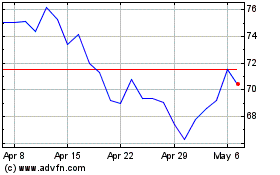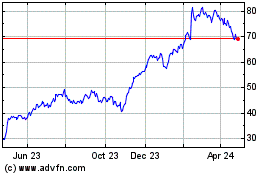By Matt Wirz, Paul J. Davies and Sam Goldfarb
High-yield bonds are weathering the coronavirus scare better
than stocks, underscoring the stark difference in investor
expectations that has prevailed for those markets in recent
months.
The prices of many sub-investment-grade bonds rose Tuesday, with
the price of Kraft Heinz Co.'s bonds due in 2046 jumping about 4%,
according to data from MarketAxess. The Dow Jones industrials fell
785.91 points, or 2.9%, on Tuesday, while the S&P 500 dropped
86.86 points, or 2.8%, in its eighth decline in nine trading
sessions.
The S&P 500 has now dropped 11% since its Feb. 19 record
closing high, while the SPDR Bloomberg Barclays High Yield Bond
exchange-traded fund has declined 2.8% since then. For the year,
the S&P 500 is down 7%, and the SPDR Bloomberg Barclays ETF,
known in the market by its ticker symbol, JNK, is down 2.3%.
Though junk-bond issuance remains slow, a few companies are
pushing forward. Cleveland-Cliffs Inc., an iron-ore miner, issued
$725 million of new secured bonds Monday, and Science Applications
International Corp. said Tuesday it would try to sell $400 million
of bonds due in 2028.
The relative stability of below-investment-grade bonds comes
after widespread warnings last year about dangers lurking in
corporate debt. While investors continue to look at developments in
the bond market, many of them say that junk bonds have continued to
be priced conservatively compared with stocks, which have spent
much of the past five years in valuation territory that makes many
buyers uncomfortable.
"One of the reasons we think credit is performing well compared
to stocks is that stocks have been really expensive and pricing in
double-digit earnings growth this year," said Will Smith, a
high-yield portfolio manager at AllianceBernstein.
Rising Treasury bond prices have also given some ballast to the
junk-debt market. The 10-year U.S. Treasury yield fell Tuesday
below 1% intraday for the first time ever before ending the day at
1.005%, an all-time closing low. Lower bond yields mean higher
prices.
The larger the spread between the yield on junk debt and
Treasurys, the more attractive below-investment-grade debt becomes
as an alternative to investors.
"If you're looking at how to generate income in a portfolio when
the 10-year yields below 1%, high yield with spreads approaching
5.50 [percentage points] starts to look much more attractive," said
Robert Hoffman, head of research for the money manager FS
Investments.
Fallout from the coronavirus epidemic has weighed heavily on the
bonds of such firms as the tourism group TUI AG and the energy
company Chesapeake Energy Corp. Average yields increased in the
junk debt market to 6.06% on March 2 from about 5% in mid-February,
according to Bloomberg Barclays Indices data.
Even so, yields are well below levels reached during the selloff
at the end of 2018, when traders and analysts grappled with fears
that the U.S. was headed for recession. Back then the yields on the
Bloomberg Barclays U.S. High Yield Index hit a high of 8.12%.
The market for leveraged loans -- junk-rated debt that is
typically used to fund private-equity deals -- has also experienced
declines, but not as severe as at the end of 2018, according to
data from S&P Global Market Intelligence's LCD loan-research
service. The price of the corporate loans of Uber Technologies Inc.
has dropped about 1% since mid-February, according to Analytics
Data Inc., compared with a roughly 17% drop in the ride-hailing
company's stock.
The extreme tumult in the stock market is making bonds look
relatively safe.
"If you invested in equities, you were up 30% last year, but now
you're down 15% in a week," said Craig Russ, a loan-portfolio
manager at Eaton Vance. "That's why you have fixed income in your
portfolio, to dampen the volatility in equities."
The problem for investors in riskier bonds now centers on
uncertainty about how severe the economic effect of the coronavirus
epidemic will be and how individual investors will react. Heavy
outflows hit mutual funds that invest in high-yield bonds and loans
last week, and although the pace abated in recent days, it could
accelerate again on news of more outbreaks, fund managers said.
Some wonder if the junk-bond market isn't the one that is now
looking too optimistic.
"Equity markets are pricing in a good probability of a mild
recession, but the credit market isn't," said Alberto Gallo, head
of macro strategies at the London-based fund manager Algebris.
"Central bank action will probably cut the recession [risk] so we
don't get a lot of defaults, but we also know that quantitative
easing doesn't lift all boats."
Even so, some see a buying opportunity in junk bonds as prices
fall from these levels.
Mark Benbow, investment manager for high yield at Kames Capital,
is looking to pick up bonds from companies he likes such as the
supercar maker McLaren, which he says should be less susceptible to
economic-slowdown fears than other car makers and has a strong
order book.
Others say picking spots in markets can help mitigate risk.
"We know there is a demand shock coming; we just don't know how
big it is going to be," said Maya Bhandari, multiasset-portfolio
manager at Columbia Threadneedle. "We've seen credit spreads widen
quite meaningfully and a bit more value and opportunity opening up
in high yield. But there is some vulnerability too, particularly in
U.S. energy, while autos and auto parts have been hit."
Write to Matt Wirz at matthieu.wirz@wsj.com, Paul J. Davies at
paul.davies@wsj.com and Sam Goldfarb at sam.goldfarb@wsj.com
(END) Dow Jones Newswires
March 04, 2020 08:14 ET (13:14 GMT)
Copyright (c) 2020 Dow Jones & Company, Inc.
Uber Technologies (NYSE:UBER)
Historical Stock Chart
From Mar 2024 to Apr 2024

Uber Technologies (NYSE:UBER)
Historical Stock Chart
From Apr 2023 to Apr 2024
